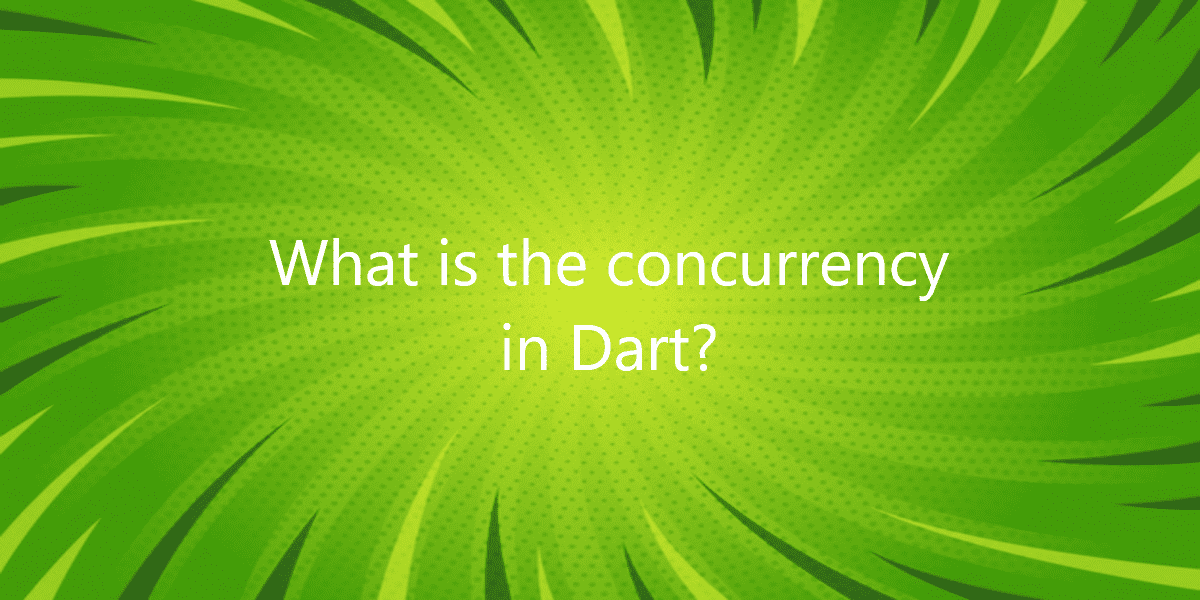What is the concurrency in Dart?
Concurrency is the simultaneous execution of several guidance groupings. So, in this article, we will see what is the concurrency in Dart.
What is the concurrency in Dart?
This includes performing multiple tasks at the same time. Dart uses isolation as a device to do the same work. The dart: isolate package is Dart’s answer to using single-threaded dart code and allowing your application to use accessible devices.
Isolates, as the name implies, is a broken unit of code that is executed. The best way to send information between them is to send the message in the same way that you forward the message between the client and the server. Isolate supports programs that take advantage of multi-core microprocessors on the outside of the housing.
What is Concurrency?
The Dart concurrency allows you to run different programs or different parts of a program at the same time. It runs multiple policies at the same time. Dart gives the isolates as a tool for doing work for equality. Simultaneity makes the program very attractive and high throughput by leveraging the undeveloped features of the basic operating system and machinery.
Simply put, this means that your application is ahead of any other company. In a typical application or program, each line of code runs consistently in sequence. However, programs that use parallel processing can always perform two functions. When attempting parallel processing on a single-core system, the CPU simply uses a scheduling algorithm to switch businesses.
How to achieve concurrency?
In darts, you can use isolates to achieve parallel processing. Here we will understand its concise expression. Dart isolate is a type of thread. However, there is a decisive difference between the normal execution of “thread” and “separation”. Isolate works as opposed to threads. Isolation is an autonomous worker that does not share a memory, ignores message channels, and connects to each other. Isolation summarizes assignments by relaying messages in this way, so an approach to serializing messages is needed.
Isolate.spawn(testing,'message_to_pass');
Isolate supports programs that utilize multi-core microprocessors from the housing. It is not possible to share variables between isolates. The best way to forward between isolations is to use message passing.
import 'dart:isolate';
void testing(var msg){
print('execution from testing ... the message is :${msg}');
}
void main(){
Isolate.spawn(testing,'Hello!');
Isolate.spawn(testing,'Welcome to Flutter Agency!');
Isolate.spawn(testing,'Hope you are okay!');
print('execution from main1');
print('execution from main2');
print('execution from main3');
}
When you run the application, you should get a screen output similar to the screen output below.
execution from main1 execution from main2 execution from main3 execution from testing ... the message is :Welcome to Flutter Agency! execution from testing ... the message is :Hello! execution from testing ... the message is :Hope you are okay!
For example, suppose you have a very complex function that runs in Isolate, but you can’t run it completely here and there.
import 'dart:isolate';
void testingFunction(var msg) {
for (int i = 0; i < 7; i++) {
print(msg + "$i");
}
}
void main() async {
Isolate.spawn(testingFunction, "Function");
print("Execution Main 1");
print("Execution Main 2");
print("Execution Main 3");
}
Here we have a for loop running on Isolate. But our for loop runs just for 4 iterations. That is because that when the loop is iterating, the main function arrives at its last line of execution. Therefore, the program is forcibly terminated with the separation function executed. When you run the application, you should get a screen output similar to the screen output below.
Execution Main 1 Execution Main 2 Execution Main 3 Function 0 Function 1 Function 2 Function 3
Assuming you need to execute the Isolate function completely, you can use asynchronous programming: Futures, Async, Wait.
import 'dart:isolate';
Future<void> testingFunction(var msg) async {
for (int i = 0; i < 7; i++) {
print(msg + "$i");
}
}
void main() async {
await Isolate.
spawn
(testingFunction, "Function");
// Isolate Function
print("Execution Main 1");
print("Execution Main 2");
print("Execution Main 3");
}
When we run the application, we ought to get the screen’s output like the underneath screen Output:
Execution Main 1 Execution Main 2 Execution Main 3 Function 0 Function 1 Function 2 Function 3 Function 4 Function 5 Function 6
Conclusion:
Thanks for being with us on a Flutter Journey!
So, in this article, we have seen what is the concurrency in Dart. Also, feel free to comment and provide any other suggestions regarding Flutter.
Flutter Agency is our portal Platform dedicated to Flutter Technology and Flutter Developers. Also, the portal is full of cool resources from Flutter like Flutter Widget Guide, Flutter Projects, Code libs and etc.
Flutter Agency is one of the most popular online portals dedicated to Flutter Technology. Daily thousands of unique visitors come to this portal to enhance their knowledge of Flutter.
Contemporary ventures
Recent blog
ready to get started?
Fill out the form below and we will be in touch soon!
"*" indicates required fields













